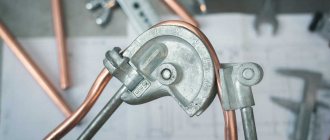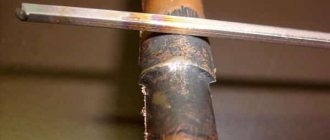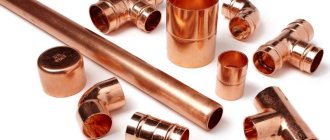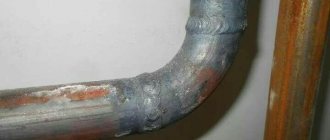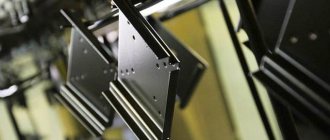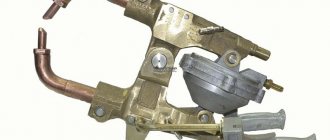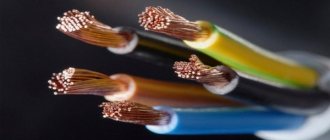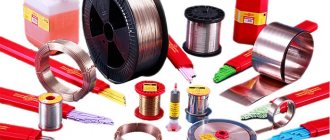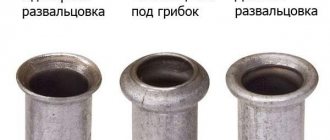Welding copper and alloys based on it requires a special approach due to the low melting point and other characteristics of the metal. There are many options for joining copper blanks. They differ depending on operating conditions and material composition.
- Preparation
- Preparation
- BUDDY TIG 160 from ESAB
Currently, there are several copper welding technologies. They are actively used in various spheres of production and life. Improved technological processes make it possible to eliminate the formation of most defects, including the appearance of pores and cracks. The work is carried out using an inverter familiar to any welder in a protective gas environment; consumables – wire and electrodes.
Copper welding technology
Before working with copper and its alloys, preparation is required. The blanks are cut and adjusted to size with a grinder, using a milling or lathe. If the workpiece has an edge thickness of 6-18 mm, then they must first be prepared. Their cut is made V- or X-shaped. A large number of parts are difficult to prepare manually. It will be justified to purchase a special edger-beveler.
The joints are cleaned of paint, oxides, fats and dirt. To obtain a high-quality welded joint, the work area must be protected from atmospheric air. Sometimes the workpieces need to be preheated. Copper is connected with consumable electrodes using a short arc. The length of the discharge should not exceed 4-5 millimeters. Pulsed arc welding technology is ideal for these purposes. It is performed in a protected environment (usually in argon) and allows you to weld even thin sheets of metal and form a seam in any spatial position, including on the ceiling.
Preparatory activities
To weld or solder copper, you must also follow the rules for preparing the metal before welding so that the result does not disappoint you. Depending on the type of part (pipe, sheet, workpiece, etc.), it is first cut into separate parts, if necessary. Copper can be cut using a grinder, pipe cutter or machine. Plasma arc cutting is also possible. Do not use a grinder or other similar tools.
Next you need to cut the edges of the part. This is done mechanically. You also need to clean the metal and wire from oxide film and dirt, the part should literally shine. Degrease the metal. Sand the edges by hand using fine-grit sandpaper. You can also use a brush with stiff metal bristles for these purposes.
Do not use a brush or coarse sandpaper that is too hard, otherwise you will damage the metal. Also recommends etching the filler wire and the part. Etching is performed in a special solution that you can prepare yourself. The main component can be nitric, sulfuric or hydrochloric acid. The acid is mixed with water and wire blanks are placed into the solution. After etching, everything must be rinsed in water and dried with hot air.
If the part has a thickness of more than 1 centimeter, then it must first be heated in an oven or using a gas burner. Next, the parts need to be joined to each other. There should be a small gap between the parts; its size should not change when re-joined. To accurately join the parts, you can use tacks. The tacks themselves must also be cleaned to prevent cracks from forming.
Sometimes additional devices are used during the welding process. For example, graphite or copper pads, as well as removable screens. Shims are indispensable when welding bottom seams (or increase heat dissipation), and removable screens will be needed when welding copper outside (they will protect the welding area from the wind).
Copper welding methods
Various equipment is used for welding copper blanks - inverters, argon and gas machines, semi-automatic machines. Consumables include consumable and non-consumable electrodes, flux and additives. Arc technology for joining metals is well suited for this work.
To connect thick workpieces with flange thicknesses of 30-35 millimeters, the electroslag method is used. The inverter matches well with carbon electrode. Good results are obtained by welding copper with graphite electrodes.
Manual arc welding with electrodes
Arc welding with consumable electrodes has its own advantages and technical and economic advantages, which determined the feasibility of its use. A very important advantage of the method is its high productivity. The second is variability. The point is that manual arc welding is performed under different conditions - with a manual machine, semi-automatic; in a protective environment and submerged.
Preparatory work
If the thickness of the shelves is 6-12 mm, then it is preferable to perform a V-shaped cutting of the edges. The opening angle should be 60-70 degrees. In a situation where it is planned to form a weld seam on the outside, the angle can be reduced to 50 degrees.
The welding sheets should first be positioned at an angle relative to each other. The angle should be approximately 2.5% of the joint length.
Otherwise, it is recommended to grab the workpieces with short stitches (up to 30 millimeters) along the entire length at equal intervals. Tacks should be made with electrodes of smaller diameter, and a gap of 2-4 mm wide should be left between the sheets. If you weld sheets end to end, there is a high probability of overheating of the metal, which will inevitably lead to the formation of hot cracks.
When making tacks, the welder must clearly understand that repeated heating provokes the appearance of cracks in the metal. Therefore, when forming the main seam, they pause before tackling, cut out the temporary connection and clean the joint. This precautionary measure avoids the formation of cracks and takes little time.
Metal with a thickness of more than 12 mm should be welded after X-shaped cutting of the edges. Naturally, you will have to weld the joint on both sides. The tacks are made from the reverse side and cleaned before forming a permanent seam. In exceptional situations, when it is not possible to make an X-shaped cut, a V-shaped cut is performed. The disadvantage of this solution is that it increases the consumption of electrodes (by about one and a half times) and the time it takes to complete the work.
Welding of parts without preliminary preparation of edges or with a V-shaped groove is done on linings. They are pressed tightly against the joint. If this cannot be done, then a cushion of flux is poured underneath. It is recommended to preheat the edges to a temperature of 300-400 degrees Celsius.
Electrodes
For manual arc welding of copper, coated electrodes are used, since uncoated ones lead to the appearance of defects and oxidation of the seam; and their combustion is unstable. Most often, consumable rods are made from copper wire alloyed with manganese or silicon.
Such electrodes have a deoxidizing effect. The coating is selected with such a composition as to ensure stable arc combustion and slag formation. As a result, the seam is well formed and the quality of the welded joint is high.
Modes
To perform the work, a connection to a DC source with reverse polarity is required. Alternating current is used as an exception, since it does not allow for uniform and continuous arc burning. The use of an alternating current source is justified in cases where the protective coating of the consumable contains iron. In such a situation, the current strength increases by 40-50%. It is important for the welder to take into account that alternating current, among other things, contributes to the spattering of the melt. The table below shows approximate welding modes.
| Copper thickness, mm | 2 | 3 | 4 | 5 | 6 | 7-8 | 9-10 |
| Electrode diameter, mm | 2-3 | 3-4 | 4-5 | 5-6 | 5-7 | 6-7 | 6-8 |
| Current strength, A | 100-120 | 120-160 | 160-200 | 240- 300 | 260-340 | 380-400 | 300-420 |
| Operating voltage, V | 25-27 | 25-27 | 25-27 | 25-27 | 26-28 | 26-28 | 28-30 |
Productivity is 15-18 meters of weld per hour of work. To increase productivity, you need to use bronze electrodes. Since copper alloy has a lower melting point, it takes less time to form a weld.
When working with workpieces with a thickness of more than 10 millimeters and a consumable diameter of 6-8 mm, you need to increase the current to 500 amperes. T-bar blanks are connected in the same way as butt blanks. The seam is formed using the boat method.
Execution technique
Parts with thick edges are welded in several passes. Each laid layer is cleaned before the next one is formed. It is advisable to join thin and medium-thick workpieces in one pass. The operation is performed in a reverse step manner. The length of individual sections is 20-30 cm.
The joint is divided into two unequal sections: one 2/3 of the total length and the other 1/3. The longer section is welded first towards the shorter one. After this comes the turn of a short segment. This technique significantly reduces the likelihood of cracks forming in the connection.
Welding work is performed in the lower position with an angle forward, that is, the rod is tilted 15-20 degrees in the direction opposite to welding. If the optimal gap between the edges is not maintained, then there is a high probability of swelling. Then the seam must be trimmed periodically with a hammer. Therefore, you cannot use graphite pads (they will crack), but it is better to use steel or copper ones.
Quality
By means of manual arc welding, high-quality connections are formed. Forging a joint improves its strength by about 10-20%. The other side of the coin: after forging, ductility decreases.
Welding copper pipes
Electrodes "Komsomolets-100" are suitable for work. The process is performed in reverse polarity with connection to a direct current source. The welding current density is 50A/mm.
The working area must first be heated to a temperature of 250-300 degrees Celsius. Pipes with a diameter of up to 50 mm are heated completely, and in the case of connecting mains with a larger diameter, they are limited to local heating. Pre-pot holders are made. As the main seam progresses, the tacks are removed, since repeated heating leads to an increase in the number of pores. Standard labor productivity for such work is 15 meters of seam per hour of work. It is necessary to avoid overheating the metal above 350 degrees Celsius.
Features of welding aluminum wires
The use of aluminum cores is prohibited by the current PUE. But in some older homes you can still find this type of wiring. A complete replacement entails financial costs and can take a long time. But for welding aluminum wires it is necessary to take into account a number of specific points.
They are as follows:
- cleaning contact parts from oxide film;
- use of special flux for aluminum welding;
- treating the welding area after cooling with quick-drying varnish.
The use of mechanical types of connections for aluminum wires is not recommended. Also, you cannot twist wires made of this material with copper ones. To do this, use special adapters.
Manual welding with graphite or carbon electrode
This method is used to connect low-critical products. Carbon electrodes are used when working with copper up to 15 mm thick. Workpieces with thicker walls are welded with graphite consumables. Each option requires a connection to a direct current source of straight polarity. The current density varies in the range of 200-400A per square centimeter.
The additive is not immersed in the melt, but is kept at a distance of 5-7 mm at an angle of 30 degrees. The electrode is tilted slightly: the angle is approximately 75-85 degrees. The weld is protected from oxidation using a flux consisting of fused borax (96%) and magnesium (4%). Flux, previously soaked in liquid glass, is applied to the edge of the electrode.
If the metal thickness is more than 5 mm, preliminary cutting of the edges is required. The overall angle is 70-90 degrees. The workpieces are placed with a gap of up to 0.5 mm. A graphite or asbestos plate can serve as a lining. The electrode is guided at an angle forward. Workpieces up to 5 mm thick are forged without heating, and parts with thicker walls are preheated to a temperature of 800 degrees, after which they are quickly cooled. It is advisable to weld in one pass, as this ensures the best performance of the joint.
Welding difficulties
It is necessary to follow the recommendations of the masters, because... metal has different characteristics from other components. Main difficulties and issues arising in the process:
- Liquid fluidity complicates the connection of seams in a vertical position. In the lower position, welding is carried out using a gasket; vertical works are available in short-term mode.
- The high degree of thermal conductivity of the material will require the use of methods to remove heat from the joining area.
- Linear expansion during heating affects an increased tendency to deformation and crack formation.
You should also remember about the ability to absorb oxygen and hydrogen when exposed to high temperatures. The tendency to oxidation requires the use of special gels consisting of silicon, phosphorus or manganese.
Manual arc welding with argon
Copper bonding in a shielding gas environment is performed using tungsten electrodes when directly connected to a DC power source. Metal with a thickness of over 4 millimeters is preheated to a temperature of 800 degrees Celsius. For the additive, a rod made of copper, bronze or copper-nickel alloy is used.
For metal thicknesses over 6 mm, a V-shaped cutting of edges with an opening angle of up to 70 degrees is recommended. Welding of parts is performed at an angle forward, the rod is held at an angle of 80-90 relative to the workpiece, and the filler material is held at an angle of 10-15 degrees.
Recommended welding current modes for different conductors
The magnitude of the welding current depends on the cross-section size and the number of strands in the twist: the thicker the twisted bundle, the greater the current value must be set on the welding machine:
- 2 cores, cross section of each 1.5 mm² - 70 A;
- 3 cores, cross section of each 1.5 mm² - 80-90 A;
- 2-3 cores, cross section of each 2.5 mm² - 80-100 A;
- 3-4 cores, cross section of each 2.5 mm² - 100-120 A.
The specified welding current modes are indicative. Wires from different manufacturers differ in chemical composition and declared cross-section, and welding devices also differ in their characteristics. Therefore, it is better to select the value of the welding current practically on a small section of the same wire. When choosing a mode experimentally, the optimal one will be when the arc is stable and the tip of the electrode does not stick to the welding site.
For modern inverter-type devices:
- stable welding discharge, ensuring high-quality welding work;
- When welding, liquid metal does not splash;
- the arc does not blind the welder due to the low melting point of copper;
- inverters are not heavy, their dimensions are small, which allows them to be carried to the installation site on a belt.
Automatic and semi-automatic submerged arc welding
To increase productivity and improve the quality of welded joints, automatic and semi-automatic welding machines are used in industrial production. The connection of parts made of copper of small thickness is successfully performed under submerged arc with non-consumable electrodes.
Preparation
The edges are cleaned, and the workpieces are located at a distance of 1-1.5 millimeters. If the thickness of the shelves exceeds 6-8 mm, then preliminary V-shaped cutting of the edges is recommended, with a total angle of 60 degrees. In this case, the parts can be placed end-to-end, without any technological gap.
When planning to weld workpieces with a gap, you need to take care of the presence of a backing. Otherwise the melt will leak out. It is best to use flux pads, but do not press them too hard onto the workpieces. Indeed, in this case, the quality of the weld root deteriorates.
It is advisable to weld copper parts with preheating of the work area. If the shelves are of small thickness, then you can limit yourself to local heating. Thick walls must be heated throughout the welding process. The same should be done when working with long joints. The heating temperature is 250-300 degrees Celsius.
Additive
Copper wire is used for welding. Thin wire must first be hardened. If this is impossible to do for some reason, then it is advisable to replace the thin copper wire with a thicker bronze one. It should be borne in mind that the use of bronze increases the likelihood of cracks.
Automatic welding of workpieces with an additive made of thin copper wire involves the use of special broaching mechanisms to automate the supply of material to the working area. In addition to thin wire, you can use wire 3 or more millimeters thick. Wire thicker than 5 mm is not used for welding copper, since in this case special current sources are required.
Fluxes, fused and unfused
Among the fused fluxes, the most widely used are:
- manganese high-silicon - AN-348, AN348A, OSTS-45;
- manganese low-silicon - PN-10, AN-51;
- manganese-free low-silicon – AN-20.
No less popular are ceramic fluxes, which allow you to alloy the melt and add deoxidizing agents to its composition. The composition of the most popular brands of such fluxes is given in the table.
| Components | Flux brand | |
| K-13 | ZhM-1 | |
| Alumina | 20 | — |
| Quartz sand | 8-10 | — |
| Magnesite | 15 | — |
| Chalk | 15 | — |
| Borax anhydrous | 20 | — |
| Fluorspar | 15-19 | 8 |
| Aluminum powder | 3-3,5 | 0,8 |
| Boron spar | — | 3,5 |
| Marble | — | 28 |
| Feldspar | — | 57,5 |
| Charcoal | — | 2,2 |
The main advantage of ceramic fluxes is that they allow you to work with alternating current sources. The most active flux is the ZhM-1 brand. It provides consistent results. When using it, the melt content is as pure as possible. The research results are shown in the table.
| Metal | Content of components, % | |||||
| Cu | Fe | Al | Si | MP | Others | |
| Basic | 99,76 | 0,016 | 0,008 | Footprints | — | 0,2 |
| Electrode wire M2 | 99,68 | 0,016 | 0,006 | Footprints | — | 0,3 |
| Shva | 99,92 | 0,048 | 0,004 | 0,009 | Footprints | 0,02 |
Modes
Most often, copper is welded with direct current with reverse polarity under submerged arc. The only exception is the option using ZhM-1 flux, which requires alternating current. Recommended welding modes are shown in the table.
Fused flux welding modes
| Copper thickness, mm | Edge preparation | Wire grade | Wire diameter, mm | Current strength, A | Wire feed speed, m/h | Welding speed, m/h |
| 2 | No | M1,M2,M3 | 1,4 | 140-160 | 120 | 25 |
| 3 | No | M1,M2,M3 | 2 | 190-210 | 140 | 20 |
| 4 | No | M1,M2,M3 | 2 | 250-280 | 170 | 20 |
| 5 | No | M1,M2,M3 | 2 | 310-320 | 210 | 20 |
| 6 | No | M1,M2,M3 | 2 | 330-340 | 220 | 20 |
| 4 | No | M1,M2,M3 | 3 | 370-390 | 150 | 38-42 |
| 5 | No | M1,M2,M3 | 3 | 380-400 | 160 | 30-35 |
| 6 | No | M1,M2,M3 | 3 | 460-470 | 175 | 30-35 |
| 81 | V-60°, blunting | M1,M2,M3 | 3 | 360-380 | 150 | 20 |
| 82 | V-60°, blunting | M1,M2,M3 | 3 | 390-410 | 160 | 20 |
| 101 | V-60°, blunting | M1,M2,M3 | 3 | 470-490 | 200 | 20 |
| 102 | V-60°, blunting | M1,M2,M3 | 3 | 540-560 | 220 | 20 |
| 121 | V-60°, blunting | M1,M2,M3 | 3 | 510-530 | 200 | 20 |
| 122 | V-60°, blunting | M1,M2,M3 | 3 | 580-600 | 240 | 20 |
| 122 | V-60°, blunting | M1,M2,M3 | 4 | 500-510 | 120 | 20 |
| 122 | V-60°, blunting | M1,M2,M3 | 4 | 570-580 | 140 | 20 |
| 14 | V-60°, blunting | M1,M2,M3 | 4 | 530-540 | 130 | 20 |
| 12 | V-60°, blunting | M1,M2,M3 | 4 | 600-610 | 150 | 20 |
| 16 | V-60°, blunting | M1,M2,M3 | 4 | 570-580 | 140 | 20 |
| 16 | V-60°, blunting | M1,M2,M3 | 4 | 650 | 160 | 20 |
| 3 | No | BrKMts3-1 | 2 | 340-350 | 250 | 70-75 |
| 4 | No | BrKMts3-1 | 2 | 350-370 | 260 | 60-70 |
| 5 | No | BrKMts3-1 | 2 | 380-420 | 270 | 45-55 |
| 6 | No | BrKMts3-1 | 2 | 450-470 | 300 | 26-32 |
| Note. Index values: 1 - first layer; 2 - second layer. | ||||||
Welding modes under ceramic flux ZhM-1
| Copper thickness, mm | Wire diameter, mm | Current strength, A | Operating voltage, V | Welding speed, m/h |
| 4 | 4 5 | 490 550 | 22-24 22-24 | 42 37 |
| 6 | 4 5 | 580 640 | 26-28 26-28 | 32 28 |
| 8 | 4 5 | 650 710 | 30-32 30-32 | 26 22 |
| 10 | 4 5 | 710 780 | 34-36 34-36 | 22 18 |
Welding modes using ceramic fluxes K-13
| Copper thickness, mm | Wire diameter, mm | Operating voltage, V | Current strength, A | Welding speed, m/h |
| 2 | 2 | 26-27 | 160-180 | 21 |
| 5-6 | 2-3 | 28-30 | 400-450 | 21 |
| 7-8 | 3 | 35-45 | 550 | 18 |
Modes of automatic submerged arc welding of copper lap joints
| Flux brand | Sheet thickness, mm | Operating voltage, V | Current strength, A | Welding speed, m/h | Wire feed speed, m/h | Character of the current |
| AN-348A | 3 | 30-35 | 220-240 | 25 | 170 | Constant |
| AN-348A | 4,5 | 30-35 | 300-340 | 25 | 230 | Constant |
| ZhM-1 | 4 | 30 | 400-450 | 32 | 81 | Variable |
| ZhM-1 | 6 | 30 | 500-525 | 25 | 87 | Variable |
| ZhM-1 | 8 | 30 | 600-625 | 23 | 95 | Variable |
| ZhM-1 | 10 | 30 | 775-800 | 18 | 103 | Variable |
| K-13 | 6 | 30 | 400-450 | Constant |
Technique
The methods for joining steel and copper have minor differences. It is advisable to connect shelves up to 8 mm thick in one pass. When working with thick workpieces that require several passes to weld, each seam must be thoroughly cleaned before applying a new one.
In automatic and semi-automatic welding, thin copper filler wire is used. Parts with walls thicker than 6 mm are pre-cut with a total opening angle of 90 degrees. To reduce the number of pores, parts are welded without transverse oscillatory movements.
For semi-automatic welding of workpieces with walls 10+ mm thick, 2 mm thick wire is used. It is advisable to complete the work in one pass. Recommended settings: voltage – 30V; current – 300A; productivity – 10 meters per hour. It is necessary to ensure oscillatory movements of the holder in the transverse direction.
Multi-pass welding requires the specialist to be attentive and accurate. To get rid of slag in the melt, you need to follow the order in which the beads are deposited. After forming the root weld, the beads are fused on the sides. The procedure for performing the work is shown in the figure.
Quality
The strength of the welded joint largely depends on the welding mode and consumables. The table shows average data for various connections performed at optimal conditions.
| Flux brand | Electrode wire grade | Mechanical strength | |||
| welded joint, MPa | weld metal, MPa | Bend angle, degrees | relative seam elongation | ||
| ZhM-1 | M2 | 177,5 | 180,4 | 180 | 41,4 |
| OSC-45 | M2 | 168,7 | 174,5 | 180 | 26,3 |
| K-13 | M1 | 258,9 | — | — | 43 (13)* |
| AN-26 | M3 | 207,9 | 203,0 | 180 | 33,8 |
| AN-348A | M1 | 192,2 | 178,5 | 180 | 41,6 |
| AN-348A | BrKMts3-1 | 234,4 | 307,9 | 180 | 33,0 |
| Note: Strength of the base metal 213.8 MPa *Test results for flat samples are given in parentheses | |||||
According to the data given in the table, we can conclude that the strength of the welded joints is not inferior to the base metal.
Types of electrodes
Round
The simple “round” type can be used indefinitely. The cross-section of the rod ranges from 3.2 to 19 mm. There are also so-called “round endless” electrodes. Of course, they have strictly limited sizes. However, the efficiency fully justifies the main name.
The diameter of the “endless” elements varies from 8 to 25 mm. Most often they are used when welding using a special machine. Both options are acceptable for “simple” welding work. However, any types of coal models, due to their infusibility, consume little.
There are also several types of such electrodes that deserve separate analysis.
Semicircular
The semicircular electrode usually has a diameter of 10 to 19 mm. Such products are often recommended for cutting metal workpieces. It is semicircular electrodes that are used by most amateur and professional welders. The seam has an optimal shape. Creating an edge with a semicircular electrode is easy.
Rectangular
They are also sometimes called flat - but not everything is so simple. When traders say the word “flat”, they may also mean square. The section size ranges from 8 to 25 mm. Most often, such tools are used when it is necessary to repair a defect in a steel casting. They are rarely used for other purposes.
Hollow
It is not often possible to find this type of electrodes. Their typical size ranges from 5 to 13 mm. It is this solution that is suitable for forming U-shaped outline lines. Hollow structures are also excellently used for vacuum welding. The pressure in the working chamber should not exceed 665 Pa.
Welding with a gas torch
Sheets up to 10 mm thick are welded with a flame with a power of 150 liters per hour of work per 1 mm of metal. Do not cook with a carburizing flame. This is fraught with the formation of cracking in the weld. The work is carried out in one pass, since reheating a previously formed seam will cause cracks to appear.
Preparation
The workpieces must be cleaned of dirt, stains, oxides, etc. The lengthwise width of the clean area is 30 cm on each side of the joint. You can clean it manually, or you can use special equipment equipped with abrasive working parts.
As practice shows, copper is most often welded end-to-end. Other connection methods - T-joint and overlap - are used much less frequently. In the first case, undercuts occur very often, and in the second, there is a high probability of lack of penetration. Therefore, instead of an overlap connection, the parts are welded end to end.
When it becomes necessary to overlap weld parts, it is important to follow a simple rule. It says that you need to weld the seam along the thick sheet from the thin side. Otherwise, there is a high probability of burning through thin metal. The figure shows two options - correct and incorrect.
Before welding copper with a thickness of 1.5-2 mm, it is necessary to flange the workpieces along the entire length of the joint. Cutting of workpieces with flanges up to 3 mm is not carried out. The parts are butt welded with a gap of 1.5-2 mm. To ensure the best possible penetration, linings with a groove are used. Without cutting, you can weld thicker sheets - up to 8 mm inclusive. But only if it is possible to form seams on both sides. The technological gap when assembling the structure is 3 mm.
Before welding copper sheets with a thickness of 3-10 mm, it is advisable to bevel the edges. The bevel angle is 45 degrees, and the gap between the workpieces is 3 millimeters. If the thickness of the shelves exceeds 10 mm, then a V-shaped cutting of the edges is performed with an opening angle of 90 degrees. Thicker workpieces are joined using two torches simultaneously with the joint positioned vertically.
Filler wire
For the manufacture of low-critical structures, wire is used, the composition of which corresponds to the base metal. But in cases where a high-quality connection is required, it is better to take wire with a deoxidizer. The filler wire intended for welding copper up to 10 mm thick contains phosphorus, and the consumable material for thicker workpieces contains silicon.
It is not recommended to use tin bronze filler wire. It has a melting point lower than copper by 150 degrees Celsius. Therefore, it will not be possible to ensure good penetration.
As for the choice of diameter, as practice shows, there is no need to take consumables thinner than 1.5 and thicker than 8 mm. The table shows the recommended wire sizes depending on the thickness of the workpieces.
| Wire diameter, mm | Thickness of welded copper parts, mm |
| 1,5 | up to 1.5 |
| 2,0 | 1,5-2,5 |
| 3,0 | 2,5-4,0 |
| 4,0 | 4,0-6,0 |
| 5,0 | 6,0-8,0 |
| 6,0 | 8,0-15,0 |
| 8,0 | over 15 |
Technology
When working with copper sheets whose thickness is 5 mm, it is advisable to install them at an angle of 7-10 degrees relative to the horizon. In this case, the filling of the cutting will be most complete. The burner is moved in the upward direction, holding it at an angle of 40-50 degrees relative to the sheet of metal. The wire is held at an angle of 30-40 degrees to the sheet.
When welding metal with a thickness of 15 millimeters or more, the sheet must be positioned vertically. Work is carried out on both sides simultaneously. That is, two burners are needed. They are held at right angles to the work surface. If the sheet thickness is over 20 mm, then the joint must be welded in the same way, but divided into sections up to 15 cm long. Take short breaks to forge the seams.
When welding is performed with tacks, the main seam must be formed not from the beginning, but by retreating from the edge by about a third of the total length of the joint. It is important to pay attention to the fact that 2/3 are cooked by multi-stage penetration in one direction, while the remaining part is cooked in the opposite direction. This technique is recommended for all methods of welding copper sheets.
Quality
How well the job is done depends not only on the skill of the specialist. Quality is also determined by the welding mode, the composition of the additive and flux, and the type of welded joint.
Copper gas welding is characterized by relatively low productivity. It is very difficult to achieve good quality with a T-joint. Even specialists with extensive experience in performing such operations often experience defects. It is difficult to maintain the optimal temperature of the weld pool. And with the slightest overheating, a large number of pores are formed.
The quality of the weld is improved by forging, but not always. It will be of no use if the sheet thickness is less than 4 millimeters. As a result of forging, the connection becomes brittle and internal stresses are created.
A little theory
Copper and its alloy (bronze and nickel) are used in many industries due to their electrical and thermal conductivity and anti-corrosion properties. Melting point of the material is 1083°C. The thermal conductivity of pure copper is 2 times greater than that of aluminum, therefore, when welding with argon, good heating of the metal is necessary.
Copper and alloys are divided into several grades. To obtain a high-quality welded joint, it is better to use deoxidized or oxygen-free copper, as they contain little oxygen.
The main filler compositions for welding copper with argon are presented in the table.
But in practice, metals of similar composition are usually used (what can be found in a home workshop).
Also, for better melting and fusion of metal, rods with a thin coating of a layer of flux are used.
Material preparation (cleaning)
Argon welding of copper cannot be done without thoroughly cleaning the material. Take any abrasive tool and clean the welded area until it shines. Next, the material is degreased using any solvent.
Material preparation is an important procedure
Take a responsible approach to cleaning copper products - this affects the quality of the connection.
To avoid defects (lack of fusion, slag inclusions), preheat the material to a temperature of 350-600°C. The temperature difference depends on the base metal, filler metal and edge preparation. Determined empirically.
Video: how to prepare a crack in a gas copper radiator for welding.
Argon welding (TIG mode)
This technology, according to welders, is the best; the seams are neat and durable. Welding copper with argon is performed with a tungsten electrode using direct current. But, with an alloy of aluminum bronze, it is better to make the connection using alternating current.
The current settings of the device are selected depending on the thickness of the product and the diameter of the electrode. Table to help:
In addition to argon, nitrogen, helium and their mixtures can be used as protective gases. All of the gases listed have their pros and cons. But argon is still more in demand for welding work.
Filler rods are selected according to the composition of the material. But usually, in a home workshop, copper wires obtained from electrical cables or a transformer are used. First, the copper core is cleared of varnish with sandpaper and degreased with a solvent.
It is good if the obtained filler wire has a lower melting point than the product prepared for welding.
Some advice from experienced welders:
- Always add the additive in front of the burner;
- Argon welding for thick copper can be performed without filler wire;
- It is recommended to run the burner in zigzags to ensure better adhesion of the metal;
- thin material must be welded with short seams intermittently to avoid burns;
- if the device does not have the “crater filling” function, then the burner must be withdrawn gradually (lengthening the arc);
- Argon welding is carried out in a vertical and horizontal position of the seam.
Video: heating and joining copper.
Welding copper pipes
When connecting copper pipes with argon, the current is set to small. Welding is carried out slowly, in separate pieces of the seam, with an overlap of at least 1/3. The filler wire is pushed away by the lateral movements of the torch. The principle is simple:
- drip - stretch;
- add and stretch again.
The best option is to have a machine with a pulse welding function. The current can be set higher so that the filler material melts quickly. Adjust the time between pulses so that the copper has time to cool down after the pulse is given (protection against burn-through). Also correctly set the time of the “crater filling” function.
PS Welding copper pipes or flat products for each material requires selecting the current using the random method. It is advisable to carry out tests on materials of similar composition. There is no need to spoil the part that you are planning to weld.
Correctly selected current should provide good heating and penetration of the copper product. There should be no holes or pores. Good luck mastering the technique!
Copper materials are used in conditions with increased requirements for ductility and corrosion resistance. Copper welding is carried out when used in various areas of production, decorative parts due to their increased aesthetic properties. The thermal conductivity of the material is twice as high as that of aluminum alloys; there are many ways to join copper products. Modern technologies make it possible to avoid hot cracks, porous formations and other non-compliances with standards during operation.
Contact welding of copper
The technology is used everywhere for welding pipes, wire, tapes, and rods. But the method is most in demand for joining copper alloys.
Spot or seam varieties of contact welding are not widely used. Butt joints are also rarely used due to technological difficulties, namely: the need to retain molten metal at the ends of the workpieces. Another disadvantage is that the joints have to be heated to a greater depth, and this ultimately leads to shrinkage of the metal.
The highest quality connection is obtained when the joint is upset under current. Using this method, it is possible to obtain a weld that is not inferior in strength to the base metal. In practice, resistance welding is often used to connect copper wire using a capacitor discharge. Recommended operating modes are given in the table.
Approximate modes of contact butt welding of copper billets of a certain range
| Welding mode parameters | Rod, diameter 10 mm | Pipe 9.5x1.5 mm | Tape 44.5x10 mm |
| Installation length, mm | 20 | 20 | — |
| Melting allowance, mm | 12 | — | — |
| Allowance for draft, mm | 8 | — | — |
| Reflow speed, mm/sec | 8 | — | — |
| Settlement speed, mm/sec | 200 | — | — |
| Specific settling pressure, MPa | 372,2 | 284,4 | 215,7 |
| Specific power, kW/mm2 | 2,6 | 2,66 | 1,35 |
| Welding current, kA | 33 | 20 | 60 |
| Secondary voltage, V | 6 | 5 | 10 |
Approximate modes of butt resistance welding of copper wire using a capacitor discharge
| Wire diameter, mm | Capacitor capacity, µF | Charge voltage, V | Initial distance at the joint, mm | Upsetting force, N |
| 1,6 | 256 | 900 | 14 | 1373 |
| 2,0 | 380 | 1000 | 15 | 1373 |
| 2,8 | 380 | 1400 | 16 | 1471 |
| 3,0 | 440 | 1500 | 16 | 1569 |
| 3,0 | 1200 | 1000 | 9 | 1177 |
| 3,0 | 1200 | 800 | 5 | 1177 |
| 3,0 | 550 | 1400 | 5 | 1471 |
| 3,0 | 540 | 1300 | 8 | 1569 |
| 3,0 | 540 | 1500 | 12 | 1569 |
| 3,2 | 550 | 1500 | 14 | 1765 |
Pros and cons of welding, its varieties
The advantages of connecting wires by welding are the absence of transition resistance, which is always present in twisted or bolted connections. This is especially true when laying wiring for powerful devices. The disadvantages are the need to buy or make your own welding machine designed for twisting.
Welding work requires some skills, so the electrician who will weld the strands needs to learn at least the basics of this craft.
When performing electrical installation work in production, various types of welding are used: standard, arc spot, plasma, torsion, electron beam, ultrasonic, or various combinations thereof. For domestic use, electricians most often use a device for spot and arc welding, which operates on carbon or graphite electrodes.
This solution allows you to obtain good quality connections at a minimum cost of the necessary devices and components. When making a wire welding machine, most attention should be paid to the following characteristics of the device:
- The current strength that the device can produce. Ideally this is a variable value.
- The voltage produced by the device is sufficient to cause an electric arc - usually 12-32 Volts.
- What kind of current does the welder use - alternating or direct? If you have experience in such work, you can use variable, but for beginners it is strongly recommended to start with constant.
Since welding different metals requires different currents and voltages, universal welding machines can necessarily adjust these values. In addition, when joining different materials, you may need special fluxes that will protect the metal from oxidation or the penetration of gases from the air into it. Most universal-purpose welding machines are quite bulky and heavy, but for small welding jobs you can find inverter welders for a relatively low price that are ideal for welding wires.
If you are welding copper wires that are used in home wiring, there is no need to use very high current and voltage, so it is possible to use small-sized welding machines that fit into a standard tool case.
Welding copper with an inverter
The equipment is designed to supply direct current with direct or reverse polarity. It is recommended to use the device with short breaks. Small sections up to 4 centimeters long are welded. Afterwards you need to let them cool naturally. Hold the electrode at an angle of 10-20 degrees during operation.
The inverter in combination with carbon electrodes showed good results. To melt them, a temperature three times higher than the melting threshold of copper is required. because of this, their consumption is very small. But to work with such rods you need to have experience. The result is characterized by high oxidation resistance, density, strength and good quality. During work, the electrode is tilted at an angle of 30 degrees relative to the working surface. The current strength is set depending on the thickness of the shelf. It can vary in the range of 35-130 amperes. An inverter in combination with carbon electrodes is most often used for welding strands and wires.
Distinctive features of copper
Copper can conduct heat six times more than regular iron. Because of this, welding must be performed with increased thermal energy, and in some cases even preheating of the base metal is possible.
Under normal conditions, copper is inert, but when heated it reacts with oxygen, hydrogen, phosphorus and sulfur. Oxygen is capable of oxidizing copper at high temperatures, and above 900 °C the oxidation rate increases significantly. This is due to the fact that the initial composition of copper contains oxygen in a bound state. Cuprous oxide forms a eutectic with a lower melting point (1065 °C). The melting point of copper is 1085 oC. Therefore, the oxygen contained in it worsens its positive indicators.
Copper welding machines
Various welding machines are used to connect copper: inverters, automatic, semi-automatic, TIG. The most popular brands are ESAB, SPETSELECTROMASH, TESLA.
BUDDY TIG 160 from ESAB
The burner is switched on in two- and four-contact modes. The device is compatible with any generators. In addition to copper, it is used for welding other metals, including stainless steel.
RENEGADE ES 300i ESAB
Equipped with built-in memory that stores several sets of settings. Independently adjusts the starting parameters depending on the current strength. The device is small and light in appearance and packs a lot of power. Inverters are used for welding rods. They generate current in the range of 60-110 amperes. Works great with copper and carbon electrodes.
For welding with electrodes
Most suitable for joining copper plates. As an example, the Orion 150s or 250s is lightweight and has sufficient power. Reliably welds copper with tungsten electrodes in a protective environment (most often argon).
The Resanta SAI-220 inverter can be connected to a 140-220 volt network. The device is equipped with a forced cooling system, so it does not overheat. Convenient option for field work.
For wire welding
Copper wire welding is performed using an Energomash SA-97PA20 inverter semi-automatic machine. Its weight is 13 kilograms and makes it possible to work with wires with a thickness of 0.6 to 0.9 millimeters.
The Shyuan MIG/MMA-290 model smoothly supplies consumables to the work area. The feed speed can be adjusted from 2.5 to 13 meters per minute. Can work with electrodes.
The inverter semi-automatic Soyuz SAS-97PA195 is equipped with a 60V idle speed function. The operating voltage is adjustable in the range from 15 to 23 volts. A wire of 0.8-1 mm is suitable for work. The device is convenient, reliable and weighs only 10 kg.
Properties
First of all, it should be said about the dependence of welding quality on the purity of the material. The purer the copper, the better the connection will be.
Electrical circuit of a welding machine for copper welding.
In addition to the noted quality, a number of features of this element should be highlighted that influence the welding process:
- like many other elements, cuprum interacts with oxygen, that is, it oxidizes;
- Cu has a high linear expansion coefficient;
- ability to adsorb hydrogen and oxygen;
- dependence of the metal structure on heat treatment;
- high thermal conductivity, seven times higher than that of steel;
- high turnover.
Earlier it was noted about a simpler connection of pure material. Of course, this option is quite rare, so welding is performed in a protective atmosphere or using flux.

